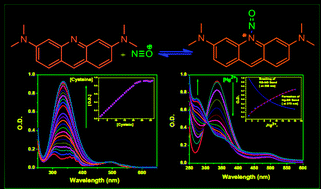Photophysical effects of nitric oxide and S-nitrosocysteine on acridine orange: use as sequential sensing platform for NO, cysteine, cysteine–NO and Hg2+ under physiological conditions†
Abstract
We report the photophysical effects of nitric oxide and S-nitrosocysteine on an antibacterial agent, acridine orange, and describe its use in sequential sensing of NO, cysteine and S-nitrosocysteine in a protein, as well as Hg2+. We show that cysteine can play a major role in controlling NO-induced resistance to bacteria.


 Please wait while we load your content...
Please wait while we load your content...